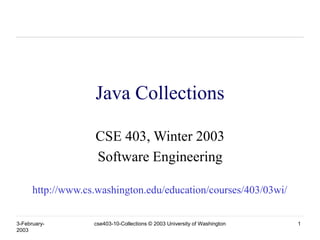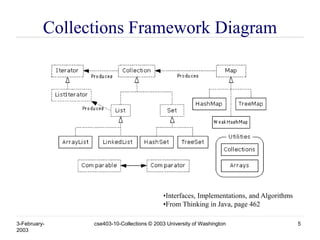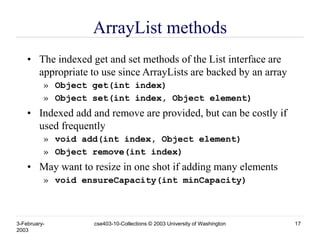The document discusses Java Collections, providing an overview of collection types, interfaces, and their functionalities in software engineering. It presents the structure of the collections framework, including important containers like ArrayList, LinkedList, HashSet, and TreeSet, as well as the Map interface for key/value pairs. Additionally, the document covers methods, bulk operations, utilities, and legacy classes relevant to managing collections in Java.








![3-February-
2003
cse403-10-Collections © 2003 University of Washington 9
Example - SimpleCollection
public class SimpleCollection {
public static void main(String[] args) {
Collection c;
c = new ArrayList();
System.out.println(c.getClass().getName());
for (int i=1; i <= 10; i++) {
c.add(i + " * " + i + " = "+i*i);
}
Iterator iter = c.iterator();
while (iter.hasNext())
System.out.println(iter.next());
}
}](https://image.slidesharecdn.com/collections-240424142153-d1931046/85/Collectionsand-GenericsInJavaProgramming-ppt-9-320.jpg)






![3-February-
2003
cse403-10-Collections © 2003 University of Washington 16
ArrayList overview
• Constant time positional access (it’s an array)
• One tuning parameter, the initial capacity
public ArrayList(int initialCapacity) {
super();
if (initialCapacity < 0)
throw new IllegalArgumentException(
"Illegal Capacity: "+initialCapacity);
this.elementData = new Object[initialCapacity];
}](https://image.slidesharecdn.com/collections-240424142153-d1931046/85/Collectionsand-GenericsInJavaProgramming-ppt-16-320.jpg)















![3-February-
2003
cse403-10-Collections © 2003 University of Washington 32
Bulk Operations
• In addition to the basic operations, a Collection may
provide “bulk” operations
boolean containsAll(Collection c);
boolean addAll(Collection c); // Optional
boolean removeAll(Collection c); // Optional
boolean retainAll(Collection c); // Optional
void clear(); // Optional
Object[] toArray();
Object[] toArray(Object a[]);](https://image.slidesharecdn.com/collections-240424142153-d1931046/85/Collectionsand-GenericsInJavaProgramming-ppt-32-320.jpg)






